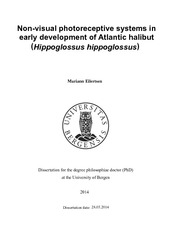Non-visual photoreceptive systems in early development of Atlantic halibut (Hippoglossus hippoglossus)
Doctoral thesis

Åpne
Permanent lenke
https://hdl.handle.net/1956/18867Utgivelsesdato
2014-03-28Metadata
Vis full innførselSamlinger
Sammendrag
Non-visual photoreception is thought to be involved in a range of behavioural and physiological processes in teleost fishes, such as synchronisation of circadian and circannual rhythms, but also regulation of skin pigmentation, buoyancy in the water, hatching of eggs and phototaxis. Knowledge of the teleost photoreceptive system and the photopigments involved is far from complete. Especially, the function of the photoreceptive system at early stages of development, the neuronal integration of the photoreceptor cells and the role of different photopigments need to be elucidated. This thesis describes the identification of several non-visual opsins in Atlantic halibut (Hippoglossus hippoglossus). Four melanopsins, two isoforms of vertebrate ancient opsin and exorhodopsin have been described. The non-visual opsins identified in this present work show refined and extensive expression from early life stages of Atlantic halibut. Expression studies show non-visual opsin positive cells in a wide range of brain regions and in the spinal cord of halibut. The expression is detected early in development, at the period of the light regulated hatching process, when the embryo is poorly developed without functional eyes. Further on, the extensive expression of non-visual opsins persists in the larval brain at first feeding when the eyes are functional and expression of nonvisual opsins are detected in the retina. Several of the brain regions have expression of more than one non-visual opsin, and this work studies the most apparent regions in detail. In the pineal complex melanopsin positive cells flank the expression of exorhodopsin and the two genes are expressed in cells adjacent to each other. It is suggested that the existence of two non-visual opsins in the pineal complex provides detection of light of different wavelengths and thus may have the possibility to expand the spectral information it can obtain from the environment. Melanopsin may also function as a photoisomerase providing 11-cis retinal to exorhodopsin. A transient, bilateral cluster of cells in the hindbrain is also described in the thesis. This cluster expresses both melanopsin and vertebrate ancient (VA) opsin thought to be of different evolutionary heritage and the work demonstrate for the first time in vertebrates that mRNAs of both photopigments are expressed within the in the same cells. Further on, the thesis indicates that the transient hindbrain cluster expressing both melanopsin and VA opsin is involved in the light-regulated hatching process of halibut. The results show that the cluster is connected to a neuronal network with projections out in the yolk sac, reaching the narrow belt of hatching gland cells. In addition, studies on light-arrested eggs demonstrate expression of the immediate early gene c-fos in the hindbrain cluster and in the hatching glands after dark induced hatching. These results indicate that the photosensitive hindbrain cluster regulates hatching in halibut and that this process is dependent on neural signalling. The thesis gives an example of a teleost embryo that organises the non-visual system with a combination of dispersed and aggregated photoreceptor cells. The neuronal identity of the photoreceptor cells can either be primary sensory neurons (first-order) or interneurons (high-order). The melanopsin positive cells identified in the spinal cord at the stage of hatching are dispersed, and may represent the first example of dispersed high-order photoreceptor cells. The work has identified several photosensitive clusters in brain regions with retinal and pineal innervations, and they may be interneurons modulating the incoming signal before it is transmitted. In addition, the aggregated cells of the hindbrain cluster may function as primary sensory cells in regulation of hatching or they may be modulating the signal. Photoreceptive organs are well described in the literature, but much less are known about the high-order photoreceptor cells and the early non-visual photoreceptive system in halibut can be a good model of such studies.
Består av
Paper I: Eilertsen, M., Drivenes, Ø., Edvardsen, R. B., Bradley, C. A., Ebbesson, L. O., & Helvik, J. V. (2014). Melanopsin and exorhodopsin in the pineal complex of Atlantic halibut (Hippoglossus hippoglossus). Published as: Exorhodopsin and melanopsin systems in the pineal complex and brain at early developmental stages of Atlantic halibut (Hippoglossus hippoglossus). Journal of Comparative Neurology, 522(18), 4003-4022. The article is available in the thesis. The article is also available at: https://doi.org/10.1002/cne.23652Paper II: Eilertsen, M., Drivenes, Ø., Ebbesson, L. O., & Helvik, J. V. (2014). Cellular co-expression of two photoreceptor pigments of different evolutionary heritage in a hindbrain cluster of Atlantic halibut (Hippoglossus hippoglossus). The article is available in the thesis.
Paper III: Eilertsen, M., Ebbesson, L. O., & Helvik, J. V. (2014). Non-visual opsin expressing cells in the hindbrain are involved in the dark-induced hatching process in Atlantic halibut (Hippoglossus hippoglossus). The article is available in the thesis.
Paper II and III are published as one article: Eilertsen, M., Valen, R., Drivenes, Ø., Ebbesson, L. O., & Helvik, J. V. (2018). Transient photoreception in the hindbrain is permissive to the life history transition of hatching in Atlantic halibut. Developmental biology, 444(2), 129-138. The article is available at: https://doi.org/10.1016/j.ydbio.2018.10.006